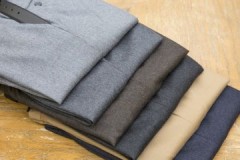Tips from experienced housewives on how to iron T-shirts from different materials
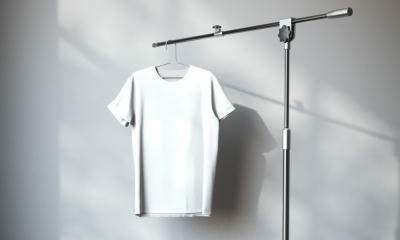 A T-shirt is a versatile piece of clothing for adults, teenagers and children. It is worn at any time of the year, can be combined with many styles, suitable for a variety of occasions.
A T-shirt is a versatile piece of clothing for adults, teenagers and children. It is worn at any time of the year, can be combined with many styles, suitable for a variety of occasions.
However, it is not only the color and print of the T-shirt that is important, but also its attractive, neat look. This can be achieved if you know how to iron a T-shirt correctly - there are many nuances of this seemingly simple process.
Content
Training
In order not to cause irreparable harm to the shirt, first you need to do a number of actions:
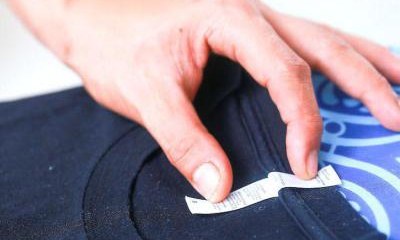 Look at the label of the thing, or rather at the information indicated on the tag - there, for example, there is a temperature regime that is allowed for ironing and the type of fabric is written.
Look at the label of the thing, or rather at the information indicated on the tag - there, for example, there is a temperature regime that is allowed for ironing and the type of fabric is written.- Check the soleplate for dirt on the iron and clean it if necessary.
- Try to start ironing before the T-shirt is completely dry - it is easier to smooth out folds on a damp cloth. A spray can also help.
- Check if not completely washed stains remain on the T-shirt - if there are, then under the influence of high temperature they will finally "weld" to the fabric.
- Prepare the workplace - instead of an ironing board, you can use any horizontal surface (for example, a table) covered with a towel or blanket.
Temperature modes
Different materials require different approaches, so it's important to know what the item is made of:
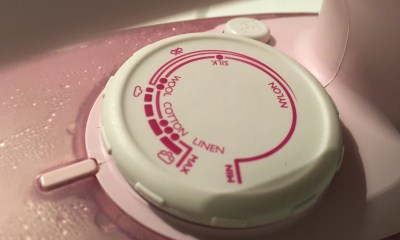 Cotton - temperature 200-220 degrees, plus moderate steaming is allowed.
Cotton - temperature 200-220 degrees, plus moderate steaming is allowed.- Viscose - temperature 120-150 degrees with careful movement of the iron.
- Polyester - ironing is usually not required, but in extreme cases, low temperatures are permissible using damp gauze or thick cloth.
- Jersey - also almost do not need ironing and imply a weak heating.
- Silk - temperature 100-130 degrees.
Mixed T-shirts must be ironed according to the directions on the label.
Ironing process
Standard products without finishing are ironed in a fairly simple sequence:
- iron, if any, pockets, as well as cuffs and collar area;
- pass the iron along the sleeves, making sure that no “arrows” appear on the folds - for this you can use a special stand for the ironing board;
- iron the back and shelf, avoiding the formation of creases.
How to quickly iron a T-shirt, the video will tell:
With print
Often T-shirts are decorated with:
- drawings,
- applications,
- rhinestones,
- sequins.
This is done to give things more originality, but this design adds complexity to heat treatment - washing and ironing.
Therefore, the algorithm of actions changes slightly:
- turn the T-shirt inside out (regardless of the fabric from which it is sewn);
- iron without touching the sole of the iron on the areas to which the decorations are applied;
- use thick paper to iron the rubber base of the stickers.
Polo (with collar and short sleeves)
The polo shirt is distinguished by the presence of a stand-up collar and button fastening. Ironing this thing is no longer so easy and, in order to do it right, you need to follow this order:
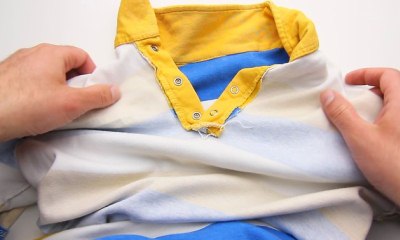 set the temperature on the iron in accordance with the indication on the T-shirt tag;
set the temperature on the iron in accordance with the indication on the T-shirt tag;- turn the T-shirt inside out and fold it in half lengthwise, straightening the collar;
- iron the thing on both sides;
- turn over and flatten the back of the T-shirt;
- turn out and iron the front side;
- gently smooth the collar with the nose of the sole of the iron;
- hang a polo shirt on a hanger.
Since modern clothing is often made from soft materials, a polo collar may not hold its shape and look not very neat... Therefore, for ironing it is advised to buy a special spray on a starch basis.
But, provided that the starch can leave traces, it is better to iron the collar from its wrong side, sprinkling with a spray.
Alternative ways
Ironing - a process that requires not only certain skills and experience, but also time. And therefore, modern technologies did not stand aside - there are devices that facilitate domestic work.
A steam generator or steamer easily smoothes areas of clothing with decorative details and buttons, and the process of such ironing itself takes no longer than a couple of minutes.
But apart from these devices there are also special presses - devices consisting of two wide plates... When heated, they smooth clothes without deforming them in any way.
Traditional methods
According to the survey results, two-thirds of people do not like to iron, in addition, there are situations when the iron is simply not at hand, as well as another ironing device. For these cases, there are life hacks that can be used if the T-shirt must be ironed:
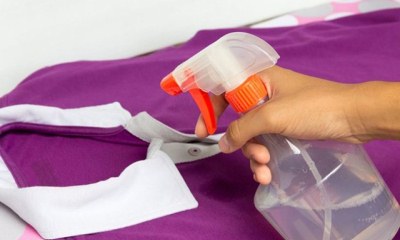 Hot water bath... If you hang a crumpled thing over it, then after a few hours under the influence of steam it will be moistened and smoothed out under its own weight. Then it must be dried.
Hot water bath... If you hang a crumpled thing over it, then after a few hours under the influence of steam it will be moistened and smoothed out under its own weight. Then it must be dried.- Vinegar solution... To prepare it, you need to mix water and table vinegar with a fabric softener in equal proportions.
Then hang the T-shirt on a hanger, evenly spray it with the resulting composition from a spray bottle and let it dry.
If the folds are small, you can try to smooth them out with steam from the teapot spout., but this is a rather risky method, because in the process you can scald your skin. You can also put on a half-dried T-shirt over yourself and wear it for a while.
For more information on how to iron a T-shirt without an iron, see this articles.
How to fold after?
If the T-shirt is not put on immediately after ironing, the question arises of how to fold it so that it does not need to be ironed again later.
There are several ways:
- Traditional - put the T-shirt back up, fold the sleeves with a part of the sides to the center, fold the bottom and fold the T-shirt in half. As in the store!
- Home - spread the T-shirt on a flat surface, roll the sleeves to the center and fold the thing first along and then across: you get an even rectangle.
-
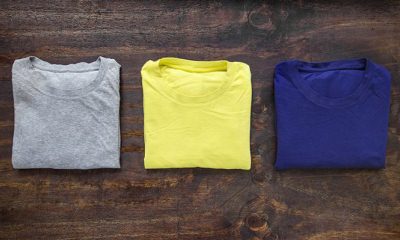 Kon Marie method - lay the T-shirt on a horizontal surface, mentally dividing it into thirds.
Kon Marie method - lay the T-shirt on a horizontal surface, mentally dividing it into thirds.Fold one third towards the center and wrap the sleeve over it, i.e. he will be on top. Fold the other edge of the T-shirt over the previous one and also roll up the sleeve.
Next, you need to fold the lower part approximately to the sleeves, then fold the folded part in half and then fold it with the upper part of the T-shirt.
To do this, you need to distribute the item on a flat surface with the collar down (making sure that it is not wrinkled anywhere), and fold the side parts of the T-shirt towards each other, bending in the middle of the shoulder. It remains to bend the sleeves, fold the edge twice, turn the item over and put it on the shelf.
4 ways to fold a T-shirt to video:
Recommendations
The following tips can greatly shorten ironing time and extend the life of your T-shirts:
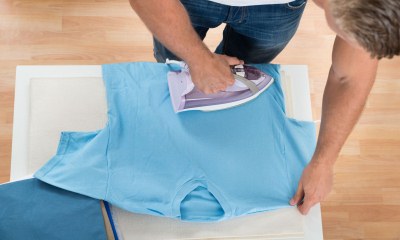 It is better to iron black or very bright T-shirts from the inside out, otherwise shiny iron marks may remain. Movements should be arched or circular.
It is better to iron black or very bright T-shirts from the inside out, otherwise shiny iron marks may remain. Movements should be arched or circular.- Ironing must be done in one direction so as not to stretch the fabric.
- It is advisable to hang T-shirts, still warm from the temperature of the iron, on hangers, and fold after they have completely cooled down. Otherwise, creases may remain on the sides.
- If the iron has a “Silk” mode, then it can be set when ironing polyester items. However, proper drying is sufficient for T-shirts made from this fabric.
- It is better to iron the knitwear without running the iron, but applying it for a couple of seconds.
Conclusion
Thus, we can conclude that ironing T-shirts is not difficult, but at the same time it requires attention to the process. However, having mastered it, you can avoid difficulties.

